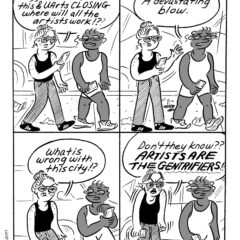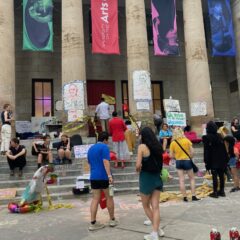The best art opening party ever from our point of view was at UArts last Wednesday–a confluence of two shows, with people crossing Broad to get from one to the other. The big-ticket half of the party was at Rosenwald-Wolf for Young Country, a traveling exhibit organized by DCCA’s Maiza Hixson. It’s exuberant and national in its draw. The show launched in Louisville, and after its Philly run (it ends July 29) Young Country travels on (we forget where but will put that info in here when we get it).
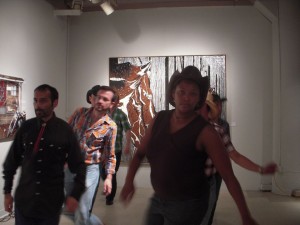
Hixson, who just stepped into the role of curator at DCCA, told us at the opening that she quite by accident got into a conversation with a bartender who said he was part of a line-dance group, and so a deal was struck. The line dancers, with their upbeat music, stomping and hand-clapping, turned the art party into a party party. The group was terrific. We’d love to tell you more about the exhibit but with the crush of flesh, the dancing, and our desire to hob-nob we didn’t absorb the art. We’ll have to go back.
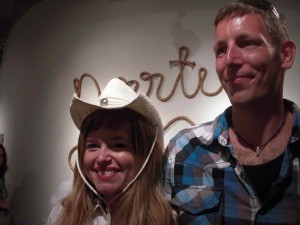
Meanwhile, in Hamilton Hall across Broad Street, people were celebrating Cosmic Bodies, an MFA show we juried. We celebrated too–the show looks great! Before both openings, we were part of a full auditorium of eager listeners for White Columns‘ Director Matthew Higgs, who speed-talked his way through a slide show about his career (pretty darned interesting).
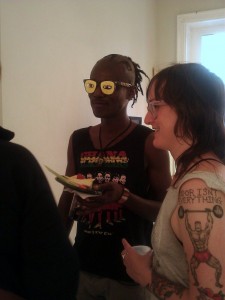
With all these great confluences of talent it seems essential to point out that Joe Girandola is the cosmic force behind it all. He brokered the deal to have the show at Rosenwald-Wolf, which is otherwise closed during July. And as the MFA program director, he organized the Food For Thought lecture series (with Matthew Higgs and others) and was the impetus behind the juried MFA exhibit.
Here’s our jurors’ statement about Cosmic Bodies, plus some pictures:
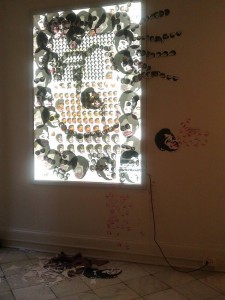
Orbs and bodies are age-old artistic motifs. Their depictions have been used to trigger narratives about the human place in the cosmos, and to raise issues about time, connectivity, life cycles and our earthly realm’s place in the universe. Cosmic Bodies raises these human and cosmic issues, sometimes with humor and other times with dead seriousness.
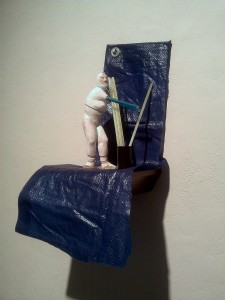
Figurative works by Sarah Nguyen, Kris Strawser and Erika Baca tease personal and universal meaning from imagery that’s both old and new. Nguyen’s nude child in a dark, threatening interior portends a coming trouble. The image is a haunting reminder of human vulnerability. Strawser’s mini 3D superhero stands ready to face the terror of the deep blue night with only a bunch of glowsticks at her command. Erika Baca’s Warhol-esque grid of Gary Coleman faces with sardine can mouths is funny at the same time that it’s full of sadness for this child actor and perhaps for humans everywhere. We all face death by playing the clown, and face the pitfalls of life, flaming out early and having no control over what our bodies and our circumstances do to us.

Speaking of sad, Lindsey Baker’s Sad Club videos grasp pop culture by the throat and wrestle with the annoying side of overheated emotions in music videos.
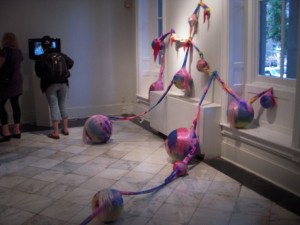
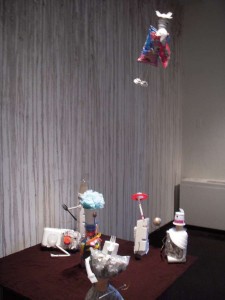
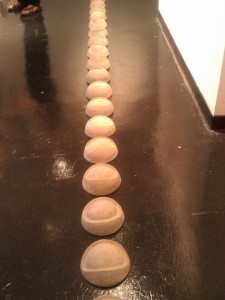
Orbs in the sculptural installations of Gina Herrera, Janine Hughes and Harry Hukkinen mark time’s passage and elicit thoughts of connectivity. Hughes and Herrera use sensual raw materials (cotton candy; coffee grounds) that trigger Proust-ian journeys into personal experience.
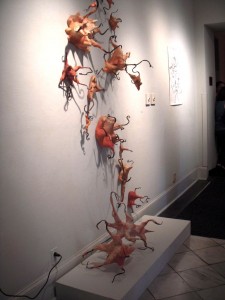
Virginia McKinney’s biomorphic forms, too, are connected — physically to each other and metaphorically to biology–macro and micro. All these connectivities are temporary and all mimic human life’s rhythms and bespeak the cycles of life, death and rebirth.



